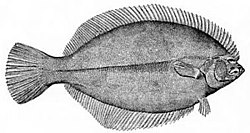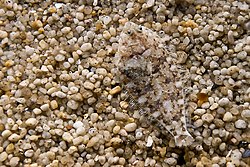Flounder: Difference between revisions
m Reverted edits by 24.213.23.244 to last version by Dylpickleh8 (HG) |
No edit summary |
||
| Line 1: | Line 1: | ||
FLOUNDER IS CURRENTLY DATING CHEESENIPS AND THEIR NICKNAME IS CHOUNDER!!!! |
|||
{{otheruses4|the fish|the Little Mermaid character|Characters of Disney's The Little Mermaid#Flounder}} |
{{otheruses4|the fish|the Little Mermaid character|Characters of Disney's The Little Mermaid#Flounder}} |
||
{{Cleanup|date=April 2007}} |
{{Cleanup|date=April 2007}} |
||
Revision as of 16:25, 16 October 2008
FLOUNDER IS CURRENTLY DATING CHEESENIPS AND THEIR NICKNAME IS CHOUNDER!!!!


Bahía de la Chiva, Vieques Island, Puerto Rico
Flounder (also; fluke) are flatfish that live in ocean waters ie., Northern Atlantic and waters along the east coast of the United States and Canada, and the Pacific Ocean, as well. The name "flounder" refers to several geographically and taxonomically distinct species. In Europe, the name flounder refers to Platichthys flesus, in the Western Atlantic there are the summer flounder Paralichthys dentatus, southern flounder Paralichthys lethostigma, and the winter flounder Pseudopleuronectes americanus, among other species. In Japan, the Japanese flounder Paralichthys olivaceus is common.
While flounders have both eyes situated on one side of the head, they are not born this way. Their life involves metamorphosis. During metamorphosis, one eye migrates to the other side of the body so that both eyes are situated on the upward-facing side of its body. After metamorphosis, flounder lie on one side on the ocean floor; either the left or right side might face upward depending on the species. Flounder sizes typically vary from five to fifteen inches, though they sometimes grow as large as three feet in length. Their breadth is about one-half of their length. Flounder are ambush predators and their feeding ground is the soft mud of the sea bottom, near bridge piles, docks, and other bottom encumbrances; they are sometimes found on bass grounds as well. Their diet consists mainly of fish spawn, crustaceans, polychaetes and small fish.
Surprise finding
Among other sea creatures, Flounders were found at the bottom of Mariana trench, the deepest location on the earth's crust. Swiss scientist Jacques Piccard and US Navy Lt. Don Walsh reached a depth of 10,900 meters (35,810 ft) and were surprised to discover soles or flounder about 30 cm (1 ft) long, as well as shrimp there.
History
Hough's Neck in Quincy, Massachusetts was once considered the "Flounder capital of the world" due to the abundance of the species there. Pollution levels in Boston Harbor during the 1980s have depleted the population, but there have been signs of a comeback.
Threats

World stocks of large predatory fish and large ground fish such as sole and flounder were estimated in 2003 to be only about 10% of pre-industrial levels, largely due to overfishing. Most overfishing is credited to the commercial fisherman.[1][2][3] Current estimates suggest that approximately 30 million flounder (not including sole) are alive in the world today. However, new research suggests that the flounder population could be as low as 15 million due to heavy over-fishing and industrial pollution risks along the Texas coast of the Gulf of Mexico.[citation needed]
According to Seafood Watch, Atlantic flounder and sole are currently on the list of seafood that sustainability-minded consumers should avoid.[4]
References
- ^ Clover, Charles. 2004. The End of the Line: How overfishing is changing the world and what we eat. Ebury Press, London. ISBN
- ^ Myers, Ransom A. and Worm, Boris. "Rapid worldwide depletion of predatory fish communities." Nature 423, 280–283 (15 May 2003).
- ^ Dalton, Rex. 2006. "Save the big fish: Targeting of larger fish makes populations prone to collapse."
- ^ "Monterey Bay Aquarium: Seafood Watch Program - All Seafood List". Monterey Bay Aquarium. Retrieved 2008-04-17.
External links
- Common names containing "flounder" at FishBase
- Flounder European flounder description and picture.
